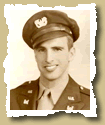| The Assault | Timeline | Maps | Men of D-Day | Photos |

|
Over Sixty years ago, a young warrant officer named James W. Tucker arrived upon a hellish stretch of beach called Omaha and survived to tell about it. “There were fires everywhere. A wrecked landing craft, still loaded with tanks, burned fiercely. Ammunition exploded. There was shellfire, noise, confusion... and bodies all around.” Waves of men and boats swept in from the sea, a part of the mightiest invasion armada in history and from the heights, German gunners tore them apart. “I was one of the lucky ones.” Jim Tucker said. “I never thought I would live through it.” On D-Day he was a proud member of the now famous 299th Engineer Combat Battalion, in charge of eight armored bulldozers. The Battalion's job: clear invasion paths through the network of German-built beach obstacles. Since late 1943, the 299th had trained at Fort Pierce, Fla., to blast out concrete pillars, deadly mine-tipped angle beams and logs and great steel crossarms called “hedgehogs.” Tucker and his men hit the sector of the beach called “Easy Red” in advance of the first wave of infantry at 6am under a rain of sniper fire from the enemy. Miraculously, all eight bulldozers got ashore in running order. Tucker stood on the beach, directing them as they rolled off the landing craft and through the surf. They struggled against time and a rising tide to blow out the water obstacles. Landing craft blew up or broached or sank. Men drowned, pulled down by heavy combat gear. The dead washed up onto the beach amidst the wreckage. “It was a sad picture.” he said. “There were bodies everywhere. You couldn't see anything but bodies.” The morning wore on. German shellfire became sporadic. New waves of assault troops came from the sea. The 299th continued to clear obstacles and mines. It was three days before they were to move off the beach. THE NEAR-MISS: “Shells started falling around me. I was near a blown-out landing craft. I hit face down. Shell fragments slashed the back of my pantlegs. It was like I'd cut myself on barbed wire.” THE TANK: “I found a tank with a dozer blade mounted in front. The crew had bailed out. So I climbed in it and ran it, clearing obstacles. Finally, I ran over a mine. It blew a tread.” THE CORPORAL: “I overheard him talking to an officer. He said that there were six men left in his entire infantry company of more than 200 and he was the highest ranking person. He was in Command.” THE GRAVE: "Part of our crew began clearing the beach of bodies but there was no place to put them. Orders came down to dig a temporary mass grave. I had one of my dozers do it. The driver kept going back and forth until he had a big enough trench. The Chaplan and I gathered men to collect the bodies. They all got sick leaving only the Chaplan and I to finish. Then the bodies were stacked in there, like cordwood and covered over with sand. I understand it was the first American graveyard in Normandy WWII." Half of the 299th Engineers were killed or wounded on Omaha Beach. Those who survived were to move inland on June 9th. In 1957 James Tucker went back to Omaha Beach with his family. He told them about it while the kids played in the German pillboxes. They visited the cemetery nearby. From a bronze plaque, he read the names of the 299th's dead. “I could recall every one of them.” He said. James W. Tucker went on to fight through the Battle of the Bulge, into Germany and win five battle stars and a Bronze Star. His Bronze Star Citation says: “In a two week period, Warrant Officer Tucker, by his marked ingenuity and untiring efforts, converted eight heavy tractors into armor protected equipment to be used in removing underwater and beach obstacles during the invasion of the European continent. On June 6, 1944, in the face of sporadic artillery, mortar and small arms fire, he personally led his crew onto the invasion beach and supervised the removal of numerous obstacles. By his technical knowledge, fortitude and devotion to duty, Warrant Officer Tucker reflects credit upon himself and the military service.” James W. Tucker was buried in Arlington National Cemetary with full military honors in 1983. The "Famous 299th Combat Engineer Battalion" also received the Presidential Citation for Outstanding Gallantry on D-Day in Normandy. Submitted by his daughter Jeannie, (September 28, 2007) |
| |
